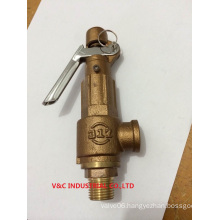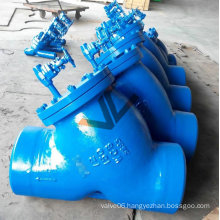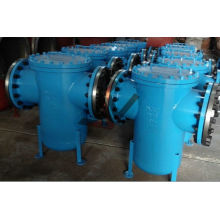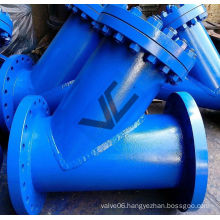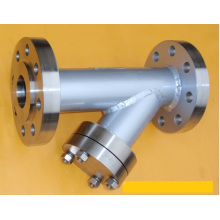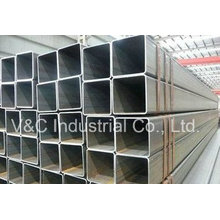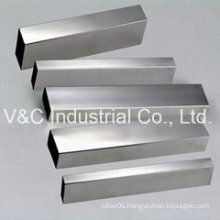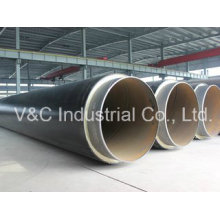Home > Industry Information > New Environmental Pre-paint Coating and Its Development
New Environmental Pre-paint Coating and Its Development
2021-05-09
The traditional metal packaging production materials mostly use cold-rolled steel sheet, hot-rolled steel sheet, or galvanized steel sheet. It is indispensable for steel drums to undergo surface treatment, painting, and drying processes during the production of steel drums. Not only is the cost high, but the quality is difficult to guarantee and the environmental pollution is also serious. In order to protect the environment and reduce costs, foreign advanced technology is to pre-coating the raw materials of steel coils. The metal packaging factory uses the pre-coated steel coils to directly manufacture the packages without coating the rear lanes, greatly simplifying the steel drums. Metal packaging production process.
Pre-coated steel coils are coated steel sheets with coils and sheets, and are supplied in roll or leaflet units to metal packaging plants for direct production into steel plates without the need for further coating. Substrate steel plate is generally 0.2~2.0mm thick steel sheet, the maximum width of up to 2m. Mainly cold-rolled steel plate, hot-dip galvanized or electro-galvanized steel plate.
Pre-coating coil coatings for metal packaging must meet the characteristics of both the production process of pre-coated coils and the processing of steel drums.
The production process is rapid roller coating construction. To ensure the thickness and leveling of the paint film, a certain construction viscosity is required. Solvent-based paints are suitable for 40~150s (coating -4 cups) and water-based paints are suitable for 28~35s. When the roller is coated, the speed of the paint roller and the bottom plate are different, and the speed between the rollers is also different. Take a full reverse three roller coating machine as an example. If the bottom plate travel speed is +100%, the paint roller is -120%. The paint roller is -140% and the control roller is -10%. Due to the large speed difference, the paint between them is subjected to a large shear force. This requires that the paint has no or only a small pseudoplasticity. That is, the viscosity of the paint is not affected by or is little affected by the shear force. Otherwise the viscosity of the coating will drop significantly with the increase of the shear force, which will make the roller unable to adhere to the required amount of coating.
In the production line, the floor travels very fast. Because there is no support, the oven cannot be too long (about 50m). The baking time of the paint in the furnace is very short, and the paint is required to be within 30 to 60 seconds below the floor temperature of 260°C. Completely cured. In addition, the drying time after painting is very short. The roller coating machine is only ten meters away from the entrance of the oven. The base plate speed is 40m/min and the distance is 15 meters. The drying time is only 22 seconds and a half. Therefore, a solvent with a suitable volatilization rate should be selected to avoid foaming, pinholes, and poor sea cucumber flatness. Commonly used solvents are alcohol ethers, ketone alcohols, and high-boiling aromatics.
From the requirements of the performance of the paint film, the coating is only one of the bottom and the top paint. The primer should have good corrosion resistance and adhesion to the substrate and topcoat. The topcoat should have good hiding power and decorative properties. It is also required that the paint film does not crack or fall off during the processing of steel drums, and it can withstand collisions and scratches during assembly, transportation, and use. That is, the paint film should have good flexibility and hardness at the same time, as well as excellent weatherability and corrosion resistance.
The latest environmental protection packaging pre-paint coating is described below.
(a) primer
Primer paint film is thin, generally 5 ~ 10μm. In addition to having good mechanical properties, it should also have excellent corrosion resistance. On the Other hand, the primer film plays a role in improving the adhesion of the topcoat paint film, especially for those topcoats that have poor adhesion to the steel substrate. Therefore, the primer film is required to have good adhesion not only with the substrate but also with the topcoat film. The most commonly used primers for precoiled membranes are epoxy, and others include polyesters and polyurethanes. Electrophoretic coating primers can also be used.
1, epoxy primer
Epoxy paint is a good metal anti-corrosion primer. The substrate steel plate and some top coats are well adhered, and have excellent flexibility and processability, and are therefore widely used as primers for pre-coated coils.
Epoxy resins used in pre-coated coil epoxy primers are generally of high molecular weight and have a molecular weight of 10,000 to 300,000. Because the low molecular weight epoxy resin can not obtain sufficient corrosion resistance and scratch resistance. The cross-linking agent can be an amino resin or a polyisocyanate. Epoxy primers using an amino resin as a crosslinker have better corrosion resistance than epoxy primers using a polyisocyanate as a crosslinker, but the mechanical properties of the former are inferior to those of the latter. Therefore, the choice of cross-linking agent should be based on comprehensive considerations such as performance requirements and cost.
2, electro-deposition paint
The electrodeposition method has been used for more than 20 years as an industrial method for coating organic substrates with steel substrates. Because the electrodeposited wet film solids content is greater than 95%, the topcoat can be applied directly to the uncured primer film by roller coating, and the two coatings are then passed through the oven simultaneously to cure.
The electrodeposition time may be 5 seconds or even less than 5 seconds on a pre-coating line. Therefore, high current densities are required for electrodeposition on a precoiled web production line.
The base material of the precoating coil electrodeposition primer includes maleic anhydride oleoresin, phenolic modified alkyd resin, epoxy modified alkyd resin, acrylic resin and polyester resin. Among the electrodeposition paints formulated with these resins, there is a common feature that a water-soluble polymer compound is added with a water-soluble chromium compound to increase the corrosion resistance and durability of the paint film.
(b) Topcoat
A wide variety of resins are available for the precoating of coil top coats. The earliest use of alkyd paint, due to its poor performance, was soon replaced by aminoalkyd paint, and later used organosol, plastisol, polyester and thermosetting acrylic paints; followed by silicone modified polyester Paints and silicone-modified acrylic paints have improved the outdoor durability of the paint film; as well as extremely durable fluorine-containing resin paints, it has also been used in large quantities. In recent years, the requirements for environmental protection and energy saving have become increasingly stringent, which has promoted the development of water-based pre-paint coatings.
The proportion of various types of paint used in the production of pre-coated coils in various countries in the world is not the same. In the future, acrylic acid, solution-type vinyl resins, and aminoalkyd resins have declined, while silicone-modified polyesters, polyesters, fluororesins, and polyvinyl chloride solutions have grown. Polyester, in particular, is currently produced in large quantities in the United States.
When selecting the type of precoating coil top coat, the following must first be considered: (1) the outdoor use of the steel drum; (2) how long the durability is required; (3) the method and degree of the steel drum forming; (4) whether there are other special performance requirements (if required Coatings, etc.)
Various types of precoating coils for metal packaging are briefly described below.
1, amino alkyd coating
As a coating material for precoating coils, aminoalkyd paints have the longest history, and they are still in use today due to their low price and good outdoor weatherability. It is often a short oil alkyd resin containing no oil, and a melamine resin as a cross-linking agent. In order to improve the film forming processability, corrosion resistance, adhesion, and chemical resistance, a third resin component such as an epoxy resin or an ethylene resin may also be added, but outdoor weatherability should be fully considered at this time.
Dry oil or semi-dry oil modified alkyd resin is added with a trace amount of dry material and then amino resin. It can also be used as a top coat for pre-coiled materials. However, due to the yellowing problem and poor outdoor weather resistance, most of the cases It is not used as a top coat.
The amino alkyd resin containing non-drying oil or synthetic non-drying oil is characterized by good construction performance, and its weather resistance is relatively good from the consideration of price. However, because of its poor formability and corrosion resistance, it has gradually been replaced by polyester or acrylic resins, and its proportion in the precoating of coil top coatings is declining year by year.
2, plastisol and organosol
Plastisols and organosols are also referred to as plastisols and diluting plastisol, customarily referred to as polyvinyl chloride-based plastisols or organosols. Polyfluorocarbons, although also used in the pre-dissolved form, are not included.
The sol-grade polyvinyl chloride powder is dispersed in a plasticizer and a volatile diluent that does not dissolve the resin at room temperature, followed by stabilizers, pigments, etc. This kind of coating is called an organic solvent coating. Solvent coatings that do not contain volatile diluents and are only dispersed in plasticizers are called plastisol. When the two coatings are baked at a temperature of 180° C. or more for a short time, the resin is swelled, melted, and further melted by the plasticizer to form a uniform and tough coating film.
Plasticizers are the key components for the preparation of plastisols and organosols. The amount of plasticizers has a great influence on the properties of the paint film, generally 1 to 40% of plasticizers. Plasticizers are high boiling, chemically stable, and thermally stable organic liquids. Its types are phthalates, adipic acid esters, sebacic acid esters, sebacic acid esters and phosphoric acid esters. When selecting plasticizers, factors such as end-use requirements, rheological properties, degassing, gelling and plasticization, and cost must be considered.
Volatile solvents can reduce the viscosity of the plastisol, making it suitable for a variety of coating processes. These solvents are divided into dispersants and diluents that affect the organosol in slightly different ways. Diluents have low solvating power and can be used alone or in combination with dispersants with higher solvating power. The more common diluents are inexpensive aliphatic hydrocarbon solvents with a wide range of boiling points. Representative dispersants such as ketones and aromatic hydrocarbons are relatively polar and usually have high volatility. Solvents can be added directly to the plasticizer either during preparation or before use.
Compared to solution type vinyl resin coatings, organosols have a low coating cost per unit area, good hardness, adhesion, and flexibility, and can be processed by sewing, embossing, punching, and the like.
The plastisol has a very high volume solids content of 97 to 100% and no volatile solvents, so it is most suitable for thick coating. Due to the poor adhesion of plastisol and metal substrates, it is generally necessary to first coat vinyl chloride/vinyl acetate copolymers with carboxyl groups, or to coat acrylic, phenolic, epoxy, polyester, and polyurethane primers first. Bake for 60 seconds at °C and apply plastisol on it. Thick coatings like this are suitable for embossing. With different plasticizer dosages, the elongation is also different. However, even if the content of plasticizer is small, the elongation of the plastisol coating film is also 180%, so all processing methods can be adopted.
3, solution type vinyl resin coating
Solution type ethylene coatings are characterized by the use of vinyl chloride-vinyl acetate copolymer as the main film coating material. The components of the paint include plasticizers, stabilizers, solvents, and thinners. It is a volatile coating and the suitable baking conditions are 230~260°C for 60 seconds.
The characteristics of solution-type vinyl coatings are as follows: 1 Easy coating (can be applied by roller coating, dipping coating, spray coating, flow coating); 2 Chemical stability (alkalinity, strong inorganic acid resistance), resistance to alcohol, grease, petroleum , Aliphatic hydrocarbons, ketones, aromatics; 3 has good adhesion, flexibility and elasticity (for joints, curling, deep drawing, rolling, pressing and other processing, the film does not damage); 4 long time No change, hardness, elasticity after storage and little change compared to the beginning); 5 Water resistance is good; 6 If the pigment is properly selected, it has excellent weather resistance; 7 The resin is light in color, so it can be made into a transparent coating; 8 Not mildew.
Due to the excellent elasticity of the solution type vinyl coating, it is possible to perform harsh processing and molding. Through long-term tests and practical use, it proves that the solution-type vinyl coating has excellent weather resistance, good adhesion to the substrate during natural exposure, adhesion remains undisturbed for a long time, it is difficult to chalk, and self-cleansing ears are heard when lightly powdered. Role, no leg color, no mildew. These properties fully satisfy the necessary conditions for precoating coil coatings.
4, acrylic paint
Acrylic resin coatings have good stain resistance, gloss, hardness, and excellent weather resistance and chemical resistance.
The disadvantage of acrylic prepaints is poor formability and generally cannot withstand deep processing. Acrylic resin is generally made of the following four monomers with different properties of the copolymer: 1 hard monomer: such as phenyl ethyl ester, vinyl toluene, methyl methacrylate, etc.; 2 soft monomers: such as ethyl acrylate, Butyl acrylate, butyl acrylate, 2-ethylhexyl acrylate and the like; 3 functional group-containing monomers: such as acrylamide, methylolated acrylamide, β-hydroxyalkyl (meth)acrylate, and acrylic acid, Methacrylic acid, monoalkyl maleate, and the like. In the design of the acrylic resin formulation, the comonomer should be selected according to the requirements for the performance of the precoating coil on the performance of the paint film, and the polymer with the expected properties should be synthesized.
Commonly used cross-linking methods can be basically divided into: 1 self-crosslinked acrylic resin - acrylamide in the polymer contained in the hydroxymethyl or its partial ether and hydroxyl, amide reaction; 2 with amino resin - Hydroxymethyl or alkoxymethyl groups of amino resins react with hydroxyl groups, amide groups, etc. on the polymer; 3 Epoxy resins - Epoxy groups of epoxy resins react with hydroxyl groups, amide groups in polymers, or rings The hydroxyl group of the oxygen resin reacts with the hydroxymethyl group of the polymer. Cross-linking method 1 is characterized by excellent coating workability, gloss, and workability, but it is often poor outdoor durability. Mode 2 is better in outdoor weather resistance and corrosion resistance, but poor in processability. When using Mode 3, weatherability must be considered.
Among the pre-coating acrylic paints worth mentioning is the electron beam cured acrylated coating. It is characterized by extremely fast curing (curing at 0.1 to several seconds at room temperature), high efficiency, energy saving, and pollution-free issues. The electron beam curing method initiates a polymerization reaction by allowing incident electrons to generate free radicals in a monomer or a prepolymer in a paint film to cure the paint film. Electron beam cured acrylic coatings are suitable for pre-thickness steel plates. The disadvantage is that the mechanical properties of the paint film are poor, and it is difficult to meet the processing and forming requirements of the pre-coated steel plate. The plasticity-improving resin is often added to improve the impact resistance, adhesion and elasticity of the paint film.
5, water-based paint
In recent years, attention has been paid to environmental pollution control and energy conservation, as well as the shortage of petrochemical products and rising flux prices, which have promoted the development of waterborne paints, and the waterborne coatings used for precoating coils have also developed accordingly.
Pre-coating water-based paint mainly includes two types, namely latex paint and water-soluble paint. Among the most successful are polyesters and acrylics. For the latter, the vast majority are cross-linked (self-crosslinking or cross-linking agents) acrylic latex paints. Both types of resins are preferably hexamethoxymethyl melamine resins as crosslinking agents. In addition to the advantages of less pollution, energy saving, and safety, acrylic latex paint has much higher molecular weight than solvent-based acrylic paint, so durability is better than solvent-based acrylic paint.
Using water as a solvent will inevitably bring about some disadvantages. The surface tension of water is large, it is difficult to wet the surface of the steel sheet, and the emulsion paint has pseudoplastic rheological properties. This means that the paint does not flow under low shear forces and the ribs are easily formed after the paint roller is applied to the steel strip. When the shearing force is high, the viscosity is too low and the stickiness does not apply to the roller, resulting in broken paint. The addition of suitable additives can increase the viscosity under high shear without affecting the fluidity of the paint and even form a smooth film under low shear forces.
In addition, even if the water-based paint is a film, there is a disadvantage that the water-based paint is more hydrophilic than the solvent-based paint. When the steel sheet pre-coated with water-based paint is used as an outer package, if water is accumulated in the overlapped portion of the steel sheet, the paint film will slightly expand due to water. Overlapping steel plates will inevitably swell due to temperature changes. Friction between the steel plates caused by this expansion and contraction may damage the swelled and soft paint film.
Burners are generally installed in baking systems in Japan and the United States. The organic solvent evaporated in the oven is discharged into the combustion furnace to be burned, and the generated heat is reintroduced into the oven. This eliminates pollution and makes full use of heat. Therefore, if water paint does not show much superiority in economy or certain properties, it will limit its development to some extent.
Development Trends and Prospects of Pre-coated Coiled Materials for Packaging:
1. Develop highly durable pre-coated coils
(1) Improve the weather resistance of the oil-free polyester coating (paint with excellent resistance to discoloration, discoloration, and powdering), and use it as an exterior coating.
(2) Vigorously develop polyfluoroolefin coatings. Through the cooperation with rust-proof substrates, pre-coated coils that are more suitable for packaging can be obtained.
(3) Using galvanized steel as the substrate, it not only has good workability but also has good corrosion resistance.
2. Development of pre-coated coils with good hardness, elasticity and stain resistance
(1) Adopt good quality coiled board material with good processability.
(2) Based on the polyester resin, the performance of this aspect is enhanced by adjusting the molecular weight, selecting the cross-linking agent, and the like.
3, lower baking temperature, shorten baking time
(1) Develop new high-efficiency catalysts and highly active curing agents.
(2) Increasing the molecular weight of the resin, polyfunctionalizing the resin and increasing the degree of branching of the resin.
(3) Development of electron beam cured coatings. A lot of research work has been done on electron beam-cured coatings for precoating coils, which have begun to be industrialized. However, compared with ordinary baking type, the history is not long, no matter whether it is variety or output, it needs further development.
4, in the packaging leader will have a larger application
(1) It can be used as an alternative to wood and paperboard to make ordinary packing boxes. It can be used as a solid, waterproof, fireproof, and corrosion resistant material. It has the incomparable advantages of wooden boxes and cartons.
(2) Replacement of ordinary thin steel plates for the production of metal containers, such as steel drums, steel cans and small barrels, has the advantages of simple processing, energy conservation and pollution reduction.
(3) Replacement of tinplate for the manufacture of goods packaging boxes, beautiful and elegant, and low cost.
(4) It can be used as a substitute for glass bottles and other packaging for food, beverages, cans, etc. to improve the safety of the packaging.
(5) It is widely used in the manufacture of large-scale packaging products such as containers and container boxes to reduce costs, save energy, reduce pollution, and simplify the processing process. Petroleum Resin (Hydrocarbon resin) is a kind of thermal plasticizing hydrocarbon resin produced by C5, C9 fraction.It is not a high polymer but a low polymer with the molecular weight between 300-3000. Featured by acid value, easy mutual solubilities, resistant to water, resistant to ethanol and chemicals.
Generally, the petroleum resins are not used independently, but have to be used together with other kinds of resins as promoters, adjusting agents and modifiers in hot-melt adhesive, pressure-sensitive adhesive, hot melt road marking paint, rubber tires and so on.
Petroleum Resin, Aliphatic Petroleum Resin, Petroleum Resin Adhesive, Petroleum Resin Paint Coating
Wofly Technology Co., Ltd. http://www.speciatyelement.com
